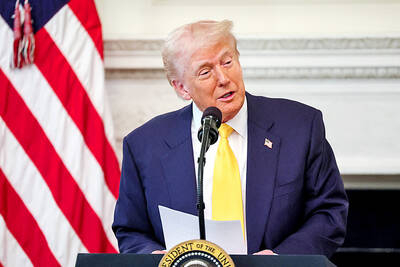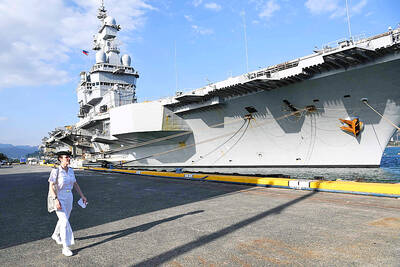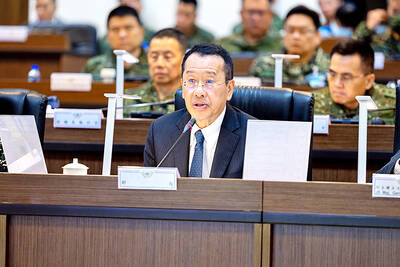Thousands of Chinese earthquake victims fled areas near the epicenter yesterday, fearful of floods from rivers blocked by landslides rattled loose in this week’s powerful temblor.
Soldiers carried older people out of Beichuan Town — one of the areas hit hardest by the magnitude 7.9 quake, whose confirmed death toll jumped to nearly 29,000 — while survivors cradled babies on a road jammed with vehicles and people.
A policeman said that rescue officials were worried water from a choked river would inundate the town.
“The river was jammed up by a landslide; now that may burst. That is what we are worried about,” the policeman said as he hurried by, not giving his name.
“I’m very scared. I heard that the water will be crashing down here,” said Liang Xiao, one of the people fleeing. “If that happens, there will be over 10m of water over our heads.”
Xinhua news Agency said earlier that a lake in Beichuan County “may burst its bank at any time.”
Residents left for higher ground, but 46 seriously injured were still at risk, the agency said.
Further north, a mountain sheared off by the quake cut the Qingzhu River and covered three villages in a valley near Qingchuan.
No traces remained of the villages, swallowed up by a huge mound of earth, behind which water from the river was backing up.
Xinhua said more than 2,000 people were evacuated from near that area.
The confirmed death toll rose yesterday to 28,881, Cabinet spokesman Guo Weimin (郭衛民) said. The government has previously said at least 50,000 people were believed killed in the disaster.
More than 10,600 people remained buried in Sichuan Province, the regional government said, according to Xinhua.
Survivors were still being found under destroyed buildings five days after the quake, as the rescue operation grew to 148,000 soldiers and police.
Rescue teams from South Korea, Singapore and Russia began work yesterday, joining Japanese specialists.

STILL COMMITTED: The US opposes any forced change to the ‘status quo’ in the Strait, but also does not seek conflict, US Secretary of State Marco Rubio said US President Donald Trump’s administration released US$5.3 billion in previously frozen foreign aid, including US$870 million in security exemptions for programs in Taiwan, a list of exemptions reviewed by Reuters showed. Trump ordered a 90-day pause on foreign aid shortly after taking office on Jan. 20, halting funding for everything from programs that fight starvation and deadly diseases to providing shelters for millions of displaced people across the globe. US Secretary of State Marco Rubio, who has said that all foreign assistance must align with Trump’s “America First” priorities, issued waivers late last month on military aid to Israel and Egypt, the

‘UNITED FRONT’ FRONTS: Barring contact with Huaqiao and Jinan universities is needed to stop China targeting Taiwanese students, the education minister said Taiwan has blacklisted two Chinese universities from conducting academic exchange programs in the nation after reports that the institutes are arms of Beijing’s United Front Work Department, Minister of Education Cheng Ying-yao (鄭英耀) said in an exclusive interview with the Chinese-language Liberty Times (the Taipei Times’ sister paper) published yesterday. China’s Huaqiao University in Xiamen and Quanzhou, as well as Jinan University in Guangzhou, which have 600 and 1,500 Taiwanese on their rolls respectively, are under direct control of the Chinese government’s political warfare branch, Cheng said, citing reports by national security officials. A comprehensive ban on Taiwanese institutions collaborating or

France’s nuclear-powered aircraft carrier and accompanying warships were in the Philippines yesterday after holding combat drills with Philippine forces in the disputed South China Sea in a show of firepower that would likely antagonize China. The Charles de Gaulle on Friday docked at Subic Bay, a former US naval base northwest of Manila, for a break after more than two months of deployment in the Indo-Pacific region. The French carrier engaged with security allies for contingency readiness and to promote regional security, including with Philippine forces, navy ships and fighter jets. They held anti-submarine warfare drills and aerial combat training on Friday in

COMBAT READINESS: The military is reviewing weaponry, personnel resources, and mobilization and recovery forces to adjust defense strategies, the defense minister said The military has released a photograph of Minister of National Defense Wellington Koo (顧立雄) appearing to sit beside a US general during the annual Han Kuang military exercises on Friday last week in a historic first. In the photo, Koo, who was presiding over the drills with high-level officers, appears to be sitting next to US Marine Corps Major General Jay Bargeron, the director of strategic planning and policy of the US Indo-Pacific Command, although only Bargeron’s name tag is visible in the seat as “J5 Maj General.” It is the first time the military has released a photo of an active